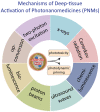Deep-Tissue Activation of Photonanomedicines: An Update and Clinical Perspectives
- PMID: 35454910
- PMCID: PMC9032169
- DOI: 10.3390/cancers14082004
Deep-Tissue Activation of Photonanomedicines: An Update and Clinical Perspectives
Abstract
With the continued development of nanomaterials over the past two decades, specialized photonanomedicines (light-activable nanomedicines, PNMs) have evolved to become excitable by alternative energy sources that typically penetrate tissue deeper than visible light. These sources include electromagnetic radiation lying outside the visible near-infrared spectrum, high energy particles, and acoustic waves, amongst others. Various direct activation mechanisms have leveraged unique facets of specialized nanomaterials, such as upconversion, scintillation, and radiosensitization, as well as several others, in order to activate PNMs. Other indirect activation mechanisms have leveraged the effect of the interaction of deeply penetrating energy sources with tissue in order to activate proximal PNMs. These indirect mechanisms include sonoluminescence and Cerenkov radiation. Such direct and indirect deep-tissue activation has been explored extensively in the preclinical setting to facilitate deep-tissue anticancer photodynamic therapy (PDT); however, clinical translation of these approaches is yet to be explored. This review provides a summary of the state of the art in deep-tissue excitation of PNMs and explores the translatability of such excitation mechanisms towards their clinical adoption. A special emphasis is placed on how current clinical instrumentation can be repurposed to achieve deep-tissue PDT with the mechanisms discussed in this review, thereby further expediting the translation of these highly promising strategies.
Keywords: Cerenkov radiation; X-ray; bioluminescence; chemiluminescence; photodynamic therapy; photonanomedicines; proton therapy; sonodynamic therapy; tumor; two-photon; ultrasound therapy; upconversion.
Conflict of interest statement
The authors declare no conflict of interest.
Figures












Similar articles
-
What NIR photodynamic activation offers molecular targeted nanomedicines: Perspectives into the conundrum of tumor specificity and selectivity.Nano Today. 2021 Feb;36:101052. doi: 10.1016/j.nantod.2020.101052. Epub 2020 Dec 16. Nano Today. 2021. PMID: 33552231 Free PMC article.
-
Biomimetic Nanotechnology: A Natural Path Forward for Tumor-Selective and Tumor-Specific NIR Activable Photonanomedicines.Pharmaceutics. 2021 May 25;13(6):786. doi: 10.3390/pharmaceutics13060786. Pharmaceutics. 2021. PMID: 34070233 Free PMC article. Review.
-
Deep-penetrating photodynamic therapy with KillerRed mediated by upconversion nanoparticles.Acta Biomater. 2017 Mar 15;51:461-470. doi: 10.1016/j.actbio.2017.01.004. Epub 2017 Jan 4. Acta Biomater. 2017. PMID: 28063989
-
Photodynamic Therapy of Cancers With Internal Light Sources: Chemiluminescence, Bioluminescence, and Cerenkov Radiation.Front Chem. 2020 Sep 4;8:770. doi: 10.3389/fchem.2020.00770. eCollection 2020. Front Chem. 2020. PMID: 33088801 Free PMC article. Review.
-
Nanomaterials for light-mediated therapeutics in deep tissue.Chem Soc Rev. 2024 Mar 18;53(6):2898-2931. doi: 10.1039/d3cs00862b. Chem Soc Rev. 2024. PMID: 38265834 Review.
Cited by
-
Towards overcoming obstacles of type II photodynamic therapy: Endogenous production of light, photosensitizer, and oxygen.Acta Pharm Sin B. 2024 Mar;14(3):1111-1131. doi: 10.1016/j.apsb.2023.11.007. Epub 2023 Nov 4. Acta Pharm Sin B. 2024. PMID: 38486983 Free PMC article. Review.
-
An overview of the feasibility of nanomedicine in pancreatic cancer theranostics.Explor Target Antitumor Ther. 2025 Jun 18;6:1002326. doi: 10.37349/etat.2025.1002326. eCollection 2025. Explor Target Antitumor Ther. 2025. PMID: 40547806 Free PMC article. Review.
-
Critical PDT Theory III: Events at the Molecular and Cellular Level.Int J Mol Sci. 2022 May 31;23(11):6195. doi: 10.3390/ijms23116195. Int J Mol Sci. 2022. PMID: 35682870 Free PMC article. Review.
-
Engineering Fe/Mn-doped zinc oxide nanosonosensitizers for ultrasound-activated and multiple ferroptosis-augmented nanodynamic tumor suppression.Mater Today Bio. 2022 Oct 5;16:100452. doi: 10.1016/j.mtbio.2022.100452. eCollection 2022 Dec. Mater Today Bio. 2022. PMID: 36245834 Free PMC article.
-
A Physiochemical, In Vitro, and In Vivo Comparative Analysis of Verteporfin-Lipid Conjugate Formulations: Solid Lipid Nanoparticles and Liposomes.ACS Appl Bio Mater. 2024 Jul 15;7(7):4427-4441. doi: 10.1021/acsabm.4c00316. Epub 2024 Jun 27. ACS Appl Bio Mater. 2024. PMID: 38934648 Free PMC article.
References
-
- Bhandari C., Guirguis M., Savan N.A., Shrivastava N., Oliveira S., Hasan T., Obaid G. What NIR Photodynamic Activation Offers Molecular Targeted Nanomedicines: Perspectives into the Conundrum of Tumor Specificity and Selectivity. Nano Today. 2021;36:101052. doi: 10.1016/j.nantod.2020.101052. - DOI - PMC - PubMed
-
- Hu J.J., Lei Q., Zhang X.Z. Recent Advances in Photonanomedicines for Enhanced Cancer Photodynamic Therapy. Prog. Mater. Sci. 2020;114:100685. doi: 10.1016/j.pmatsci.2020.100685. - DOI
-
- Obaid G., Jin W., Bano S., Kessel D., Hasan T. Nanolipid Formulations of Benzoporphyrin Derivative: Exploring the Dependence of Nanoconstruct Photophysics and Photochemistry on Their Therapeutic Index in Ovarian Cancer Cells. Photochem. Photobiol. 2019;95:364–377. doi: 10.1111/php.13002. - DOI - PMC - PubMed
-
- Spring B.Q., Sears R.B., Zheng L.Z., Mai Z., Watanabe R., Sherwood M.E., Schoenfeld D.A., Pogue B.W., Pereira S.P., Villa E. A Photoactivable Multi-Inhibitor Nanoliposome for Tumour Control and Simultaneous Inhibition of Treatment Escape Pathways. Nat. Nanotechnol. 2016;11:378–387. doi: 10.1038/nnano.2015.311. - DOI - PMC - PubMed
Publication types
Grants and funding
LinkOut - more resources
Full Text Sources
Miscellaneous

